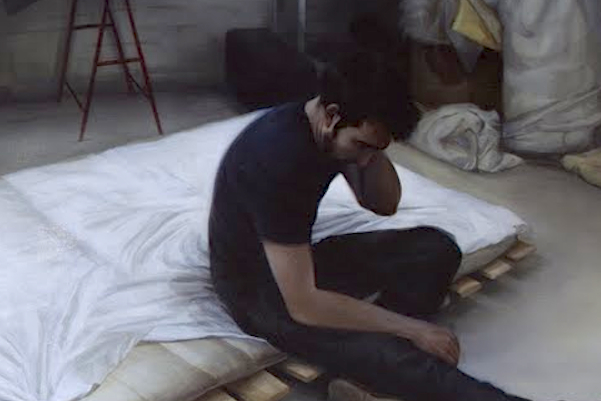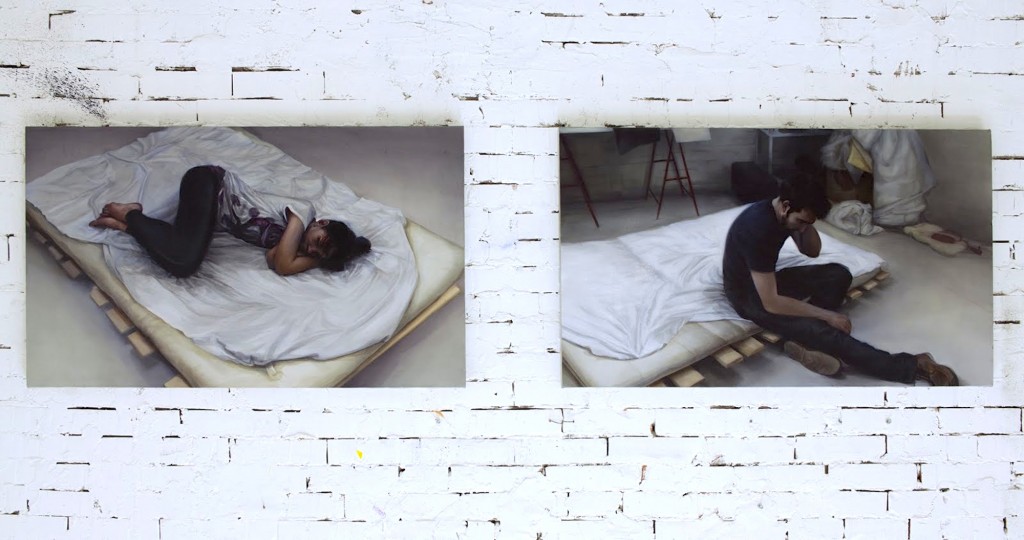Art
Painting heterotopia: An interview with Zlatan Vehabovic
Croatian artist Zlatan Vehabovic’s studio is bright and modest. Two bookshelves house thick monographs and a cluster of coffee mugs. A small couch, two chairs, and a table sit near the door. It is all rather sparse and simple: Vehabovic’s paintings take center stage. This is the kind of creative space that you might expect from an artist who speaks about his work with marked devotion. As he says, the more you love something, the more it loves you back. Painting is an act of dedication.
Today, three canvases marked with preliminary brushstrokes hang from the walls. A loosely outlined figure stands in the center of the largest canvas, his back turned toward his viewers. He wears a hooded jacket, hiding any identifying features. On the adjacent wall two smaller canvases display the same figure from a different view, a close up, and with a little more color. The jacket is red. It looks thick and slick, like a raincoat. A pair of lights dangles from the figure’s shoulder.
These are studies for a new body of work that Vehabovic, who has exhibited nationally and abroad, will be showing at Marc Strauss Gallery in New York City. He has graciously invited me into his space to take a first look. He pours us each a cup of chamomile tea, and we start talking about those enigmatic figures.
Tell me a little bit about this new series.
ZV: The first idea I had is to have these whale hunters confronted with a cave-like situation, with a lot of whale drawings on the wall. The whale hunters will be standing there and maybe doing the drawings themselves, or there will maybe be one who is shedding some light on these walls and drawings. Basically these are all studies for the first work.
Did anything in particular inspire this subject?
ZV: Basically, the new body of work is going to be dealing with a certain song that I feel very close to… It’s an old traditional song; I think it’s a Scottish song or something like that, and it’s told from a woman’s perspective. [She] is telling the story of her husband, who is a seaman working on the sea fishing whales (to be used in the creation of perfume). What I was drawn to is the very beautiful notion of the landscape involved, the sea and the two of them, separated… I feel drawn to this kind of subject matter [in which] a guy is separated from his habitat, his environment.
I came upon a revealing subject in philosophy that Foucault named heterotopia. It’s an area or a physical space, to which the subjects of law that we live by in this world do not apply. It’s a space within a space that has its own set of rules… and is completely impenetrable by anybody other than the ones who dwell in it. I wanted to see if it’s possible to create my own kind of visual world dealing with all of these subjects. The real subject is this world within the world, but using imagery from the song.
Do you ever think about departing from representation toward abstraction?
ZV: I think about it all of the time. The entire procedure of painting is very, very abstract. You’re dealing with paint, which is very physical, and what you’re doing is applying it on a two-dimensional surface… It’s an image that we read in our minds and then connect it to [reality]. So if you want to think about it in those terms, then every painting would have all of the abstraction inside of it.
I’m a great fan of high modernism, especially American. When looking at Rothko, I’m completely in awe. I mean, just looking at a Rothko painting, for me, completely translates to the ultimate freedom that is given to a man. It’s the most liberating and greatest thought put to a material that I can feel and see, ultimately.
It’s interesting that you mention Rothko, because his work is so much about creating an atmosphere. And your work does that as well. In that sense, it is not so far from abstraction.
ZV: It’s not. [Painting] shouldn’t be “what you see is what you get”. All of my recent works have a photograph that precedes them, but [the painting] has to be… diverted or manipulated in a way that, to put it bluntly, it gets soul. [This] can be everything and nothing: it’s a really complex thing to think about.
When we spoke before, we touched on the performative aspect of your work. You often stage the photographs you use as references with the help of friends who are essentially acting.
ZV: Movies are the greatest influence on me, probably. That kind of linear narrative is something that occupies my works, because usually I’m imagining a theme that I’m going to apply to a body of work. Music is also an influence. As I said, it’s always the story I get intrigued by, so when it’s music, then it’s the lyrics I’m really occupied with.
What about artistic influences? I noticed some Rembrandt and Velasquez on your bookshelf.
ZV: The old masters, yes. When I finished [the series] Sweeping the Confetti from the Floor of the Concrete Hole, I bumped into a wall, technologically. What I felt when I finished that show was that [I had no control of] these paintings. You need to know what you’re doing. Really know that if you’re going to use this color, this will happen, and this medium, then this will be produced. So, I basically devoted myself to technological issues [by studying the old masters].
When I was in the academy, I didn’t do a painting the entire time. My work was closely tied to what you now see in a lot of street art. I was producing a bunch of small, quickly executed drawings… It was more the quantity than about the quality. I would make hundreds of small, crazy drawings that had some completely self-referential, subjective point of view, and I would just put them on the wall until the wall was full.
You mentioned to me earlier that you will be spending a few months in New York early next year, before your exhibition. What are you looking forward to? Any hopes for the trip?
ZV: The plan is to finish up the works for the show, and in the meantime enjoy the fabulous city with my wife and our newborn boy. So it’s quite a lot for me, but I’m really looking forward, as I know it’s going to be great.
Written by: Elaine Ritchel (@elaineritchel)








